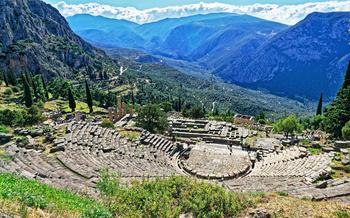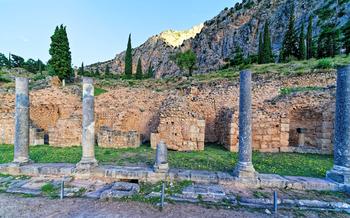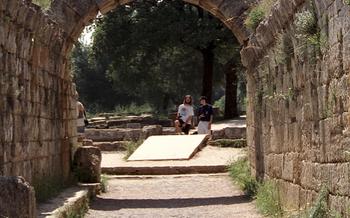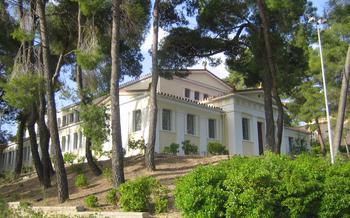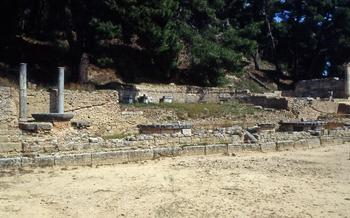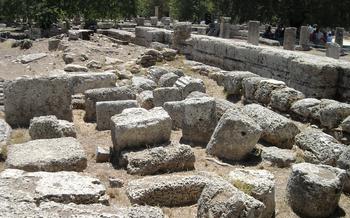
Patras Archaeological Museum
- Historical Background
- Location and Accessibility
- Museum Highlights
- Ancient Sculptures
- Mosaics and Frescoes
- Ceramics and Pottery
- Coins and Currency
- Jewelry and Adornments
- Tools and Implements
- Weapons and Armor
- Religious Artifacts
- Fun for Kids
- Accessibility and Facilities
- Insider Tip:
Historical Background
Patras, a city with a rich and fascinating history, has been a major port city since ancient times. The strategic location of Patras at the entrance to the Gulf of Patras made it a natural gateway for trade and travel between Greece and the rest of the Mediterranean.
In the 6th century BC, Patras became a member of the powerful Achaean League, which dominated much of the Peloponnese. During this period, the city flourished and became a center of commerce and culture. In the 2nd century BC, Patras was conquered by the Romans, who made it the capital of the province of Achaia.
The city continued to prosper under Roman rule, and many impressive buildings were constructed, including a theater, a stadium, and a temple to Apollo. In the 4th century AD, Patras became a Christian city, and a number of churches were built. The city was also a major center of learning, and the Patras Academy was one of the most prestigious schools in the Byzantine Empire.
In the Middle Ages, Patras was conquered by the Franks, the Venetians, and the Ottomans. The city suffered greatly during these periods of foreign rule, but it eventually regained its independence in the 19th century. Today, Patras is a modern and vibrant city, but it is still proud of its rich and ancient history.
The Patras Archaeological Museum plays an important role in preserving and showcasing the city's past. The museum houses a vast collection of artifacts from all periods of Patras' history, from the Neolithic period to the Ottoman era. These artifacts provide valuable insights into the lives and culture of the people who have lived in Patras over the centuries.
Location and Accessibility
The Patras Archaeological Museum is conveniently located in the heart of the city, making it easily accessible for visitors. The museum is situated on 21 Ermou Street, within walking distance of several other cultural attractions, including the Roman Odeon and the Patras Castle. For those arriving by public transportation, the museum is a short walk from the Patras bus station and the OSE train station. The museum is open from 8:00 AM to 3:00 PM, Tuesday through Sunday. Admission tickets cost €6 for adults, €3 for students and seniors, and are free for children under Guided tours in English and other languages are available upon request.
Museum Highlights
The Patras Archaeological Museum proudly showcases a remarkable collection of artifacts, each narrating the captivating story of ancient Greece.
-
Among the museum's highlights is the “Bronze Statuette of Apollo”, a stunning piece that embodies the essence of the Olympian god. With intricate details capturing Apollo's powerful presence, this statuette is a testament to the exceptional skill of ancient Greek sculptors.
-
Another notable artifact is the “Mosaic Floor Depicting a Dionysian Scene”, discovered at the Roman Villa of Patras. This exquisite mosaic transports visitors back in time with its vivid portrayal of the mythical figure Dionysus surrounded by his followers engaged in a lively celebration.
-
The museum also houses an impressive collection of “Gold Jewelry” that showcases the craftsmanship and artistry of ancient Greek goldsmiths. From intricate necklaces to elegant earrings, these pieces reveal the luxurious lifestyle and love for adornment that characterized ancient Greek society.
With every artifact meticulously preserved and displayed, the Patras Archaeological Museum invites visitors to delve into the rich past of Greece and gain a deep appreciation for the enduring legacy of ancient Greek culture.
Ancient Sculptures
The Patras Archaeological Museum houses an impressive collection of ancient Greek sculptures that offer a glimpse into the artistry and craftsmanship of the ancient world. These sculptures, including statues, busts, and reliefs, are not just works of art but also valuable historical artifacts that provide insights into the culture, mythology, and daily life of ancient Greece.
The museum's collection includes a variety of sculptures, ranging from small figurines to life-size statues. Among the most notable pieces is a colossal marble statue of Apollo, the Greek god of music, poetry, and prophecy. The statue stands over 2 meters tall and depicts Apollo in a majestic pose, holding a lyre in his left hand and a laurel wreath in his right. The intricate details and lifelike features of the statue showcase the exceptional skills of ancient Greek sculptors.
Another highlight of the collection is a bronze statue of Hermes, the messenger of the gods. The statue depicts Hermes with his characteristic winged sandals, a traveler's hat, and a caduceus, a staff entwined with two serpents. The statue showcases the mastery of ancient Greek sculptors in capturing movement and fluidity in bronze.
The museum also houses a collection of funerary reliefs that provide glimpses into the lives and beliefs of ancient Greeks. These reliefs often depict scenes from mythology or daily life and offer valuable insights into the customs and traditions of the ancient world.
The Patras Archaeological Museum's collection of ancient sculptures is a testament to the artistic achievements of ancient Greece. These sculptures offer a unique perspective on the culture, history, and mythology of this ancient civilization and continue to inspire and fascinate visitors to this day.
Mosaics and Frescoes
The Patras Archaeological Museum boasts a remarkable collection of mosaics and frescoes that offer a glimpse into the vibrant artistic traditions of ancient Greece. These intricate artworks adorn the museum's walls and floors, showcasing the skill and craftsmanship of ancient Greek artisans.
The mosaics, composed of tiny colored tiles, depict a variety of subjects, including mythological scenes, geometric patterns, and everyday life. One notable mosaic portrays a lively chariot race, complete with charging steeds and cheering spectators. Another depicts a tranquil garden scene, with lush foliage and colorful flowers.
The frescoes, painted directly onto the walls, feature a range of mythological and historical subjects. One striking fresco depicts the abduction of Persephone, the daughter of Demeter, by the god of the underworld, Hades. Another portrays a battle scene, with warriors clashing in a fierce struggle.
These mosaics and frescoes not only add visual interest to the museum but also provide valuable insights into ancient Greek culture. They offer glimpses into the religious beliefs, mythology, and artistic traditions of this remarkable civilization.
Ceramics and Pottery
The Patras Archaeological Museum houses a diverse collection of ceramic ware, pottery, and vases that span various periods of Greek history. These artifacts provide a glimpse into the artistic expression, craftsmanship, and everyday life of ancient Greeks.
From the humble cooking pots and storage jars to the exquisitely painted amphorae and kraters, the collection showcases the different types of pottery created by ancient Greek potters. Visitors can admire the intricate designs, vibrant colors, and delicate forms that characterize these ceramic masterpieces.
The museum's collection includes examples of both local Patras pottery and imported wares from other regions of Greece and beyond. These imported ceramics offer insights into the trade networks and cultural exchanges that existed in the ancient world.
One of the highlights of the collection is a stunning krater, or large mixing bowl, adorned with a detailed narrative scene depicting a mythological event. The intricate storytelling and the vibrant colors used in this piece make it a true masterpiece of ancient Greek pottery.
These ceramic artifacts not only showcase the artistry and technical prowess of ancient Greek potters but also provide valuable information about the daily lives, customs, and beliefs of the people who used them. Whether for cooking, storage, or religious rituals, pottery played a significant role in ancient Greek society, and the Patras Archaeological Museum's collection offers a fascinating glimpse into this rich ceramic tradition.
Coins and Currency
The Patras Archaeological Museum houses a fascinating collection of ancient Greek coins and currency, providing a glimpse into the economic and political systems of the ancient world. These coins, minted in various cities and regions across Greece, served as a medium of exchange, a store of value, and a symbol of power.
The most common type of coin in ancient Greece was the drachma, a silver coin divided into six obols. Other denominations included the tetradrachm (four drachmas), the didrachm (two drachmas), and the hemidrachm (half a drachm). These coins were typically made of silver, but some were also minted in gold, bronze, or electrum, an alloy of gold and silver.
The designs on ancient Greek coins often depicted the city or region that issued them, as well as symbols of their power or prosperity. For example, the coins of Athens featured the head of the goddess Athena, while the coins of Corinth depicted the winged horse Pegasus.
Beyond their monetary value, ancient Greek coins also played a significant role in politics and warfare. They were used to pay soldiers, finance public works projects, and commemorate important events. The minting of coins was also a way for cities to assert their independence and autonomy.
One of the most famous coins in the Patras Archaeological Museum is the "Dekadrachm of Syracuse," minted in the 5th century BC. This massive silver coin, weighing over 40 grams, features a beautiful depiction of the goddess Nike driving a chariot. It is considered one of the finest examples of ancient Greek coinage and is a testament to the skill and artistry of the ancient Greek engravers.
Jewelry and Adornments
The Patras Archaeological Museum boasts a captivating collection of ancient Greek jewelry, showcasing the exquisite craftsmanship and artistry of the ancient Greeks. From delicate gold and silver pieces to vibrant gemstones and intricate beads, these adornments offer a glimpse into the fashion, status, and symbolism of ancient Greek society.
Necklaces, earrings, bracelets, and rings adorned the bodies of both men and women, serving not only as decorative accessories but also as indicators of wealth, power, and social rank. The intricate designs and motifs featured on these pieces often held symbolic meanings, representing deities, mythical creatures, or personal protective symbols.
One of the highlights of the collection is a stunning gold necklace featuring a pendant in the shape of a crescent moon, adorned with intricate granulation and filigree work. Another remarkable piece is a pair of gold earrings embellished with colorful gemstones, showcasing the vibrant hues favored by ancient Greek artisans.
These exquisite artifacts provide a glimpse into the personal adornment practices of ancient Greeks, revealing their love of beauty, craftsmanship, and the symbolic power of jewelry.
Tools and Implements
The Patras Archaeological Museum houses a fascinating collection of ancient tools and implements that provide a glimpse into the daily lives and occupations of ancient Greeks. These artifacts, crafted from various materials such as metal, wood, and bone, offer insights into the ingenuity and resourcefulness of this ancient civilization.
Among the most intriguing tools are those used in agriculture, such as sickles, plowshares, and millstones. These implements showcase the importance of agriculture in ancient Greek society, as farming was a primary means of sustenance. Visitors can also admire a variety of tools used in construction, including hammers, chisels, and saws, which demonstrate the advanced building techniques employed by the ancient Greeks.
The museum also displays an impressive array of tools related to textile production, such as spindles, looms, and weaving combs. These artifacts highlight the importance of textiles in ancient Greek society, as clothing, bedding, and other fabrics were essential commodities. Additionally, there are tools used in metalworking, pottery, and other crafts, showcasing the diverse range of skills and industries that flourished in ancient Greece.
These tools and implements not only provide a glimpse into the practical aspects of ancient Greek life but also reveal the creativity and innovation of this remarkable civilization. Through these artifacts, visitors can appreciate the ingenuity and resourcefulness of the ancient Greeks, who laid the foundation for many modern technologies and practices.
Weapons and Armor
The Patras Archaeological Museum houses an impressive collection of ancient Greek weapons and armor, offering a glimpse into the military prowess and warfare strategies of this ancient civilization. Among the highlights are intricately crafted swords, spears, shields, and helmets that once belonged to valiant warriors and soldiers.
The museum's collection showcases the evolution of weaponry in ancient Greece, from the early Bronze Age to the Hellenistic period. Visitors can trace the development of sword designs, from the simple leaf-shaped blades to the more elaborate and effective xiphos and kopis swords. Spearheads of varying sizes and shapes demonstrate the versatility of this weapon, used both for thrusting and throwing.
Shields, an essential part of ancient Greek warfare, are represented by a diverse array of styles and materials. From the iconic round hoplite shield, made of bronze and wood, to the smaller and lighter pelta shield, favored by skirmishers and cavalry, the museum's collection provides a comprehensive overview of defensive equipment.
Helmets, designed to protect the head and face of warriors, come in various forms, each reflecting a different period or region of ancient Greece. The Corinthian helmet, with its distinctive closed face guard, is perhaps the most recognizable, while the Attic helmet, with its open face and cheek guards, offered greater visibility and breathability.
These weapons and armor pieces not only shed light on ancient Greek military technology but also evoke stories of epic battles, courageous warriors, and the strategic prowess that shaped the course of history.
Religious Artifacts
The Patras Archaeological Museum houses a fascinating collection of religious artifacts that offer a glimpse into the spiritual beliefs and practices of ancient Greeks. Among the highlights are exquisite statues of gods and goddesses, each intricately carved and capturing the essence of the divine. These statues provide valuable insights into the physical characteristics and iconography associated with various deities, allowing visitors to connect with the ancient Greek pantheon.
Also on display are votive offerings, objects dedicated to gods or goddesses in gratitude or supplication. These offerings range from simple clay figurines to elaborate bronze statuettes, reflecting the deep devotion and personal piety of ancient Greeks. These artifacts provide a tangible connection to the religious rituals and ceremonies that were an integral part of everyday life in ancient Greece.
The museum's collection of cult objects, such as altars, incense burners, and ritual vessels, further illuminates the religious practices of the ancient Greeks. These objects were used in various religious ceremonies and rituals, offering a glimpse into the sacred rites and practices that took place in temples and sanctuaries.
By exploring these religious artifacts, visitors to the Patras Archaeological Museum gain a deeper understanding of the spiritual beliefs and practices that shaped the lives of ancient Greeks. These artifacts provide a window into the sacred world of ancient Greece, allowing visitors to connect with the divine and experience the rich tapestry of Greek mythology and religion.
Fun for Kids
The Patras Archaeological Museum offers a range of interactive exhibits and activities that make the museum an enjoyable experience for children. Kids can explore the museum's collection through hands-on activities, games, and puzzles that bring history to life. There are interactive displays that allow children to learn about ancient Greek pottery, tools, and weapons through touch and play.
The museum also offers educational programs and workshops designed specifically for young visitors. These programs cover various topics related to ancient Greek history and culture, such as mythology, art, and archaeology. Children can participate in workshops where they can create their own ancient Greek pottery, learn about the process of minting coins, or dress up in traditional Greek costumes.
To keep kids engaged and entertained throughout their visit, parents can encourage them to participate in the museum's scavenger hunt. The scavenger hunt provides children with a list of items to find within the museum's exhibits, making learning a fun and interactive adventure.
Accessibility and Facilities
The Patras Archaeological Museum is committed to providing a welcoming and accessible environment for all visitors. Wheelchair ramps and elevators ensure that the museum is fully accessible to visitors with mobility impairments. Accessible restrooms are also available for the convenience of visitors.
For those who prefer a more in-depth exploration of the museum's collection, guided tours are available in a variety of languages. Audio guides are also available for self-guided tours, allowing visitors to learn more about the artifacts at their own pace.
After your visit, be sure to stop by the museum's gift shop, where you can purchase souvenirs and books to commemorate your experience. The gift shop offers a wide selection of items, including replicas of ancient artifacts, jewelry, and books on Greek history and archaeology.
Insider Tip:
To enhance your experience, consider dining at one of the charming tavernas near the museum, savoring authentic Greek cuisine while soaking in the city's vibrant atmosphere. After your cultural immersion, take a leisurely stroll to the picturesque Patras Castle, a testament to the city's rich history. Capture the beauty of the museum's artifacts and the city's landmarks with your camera, preserving memories of your visit to this captivating destination.
